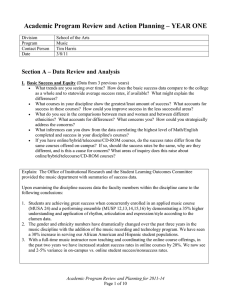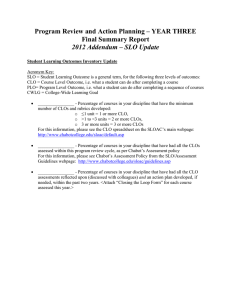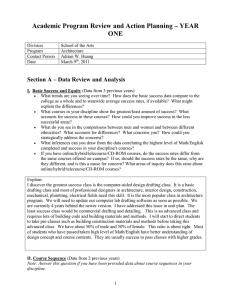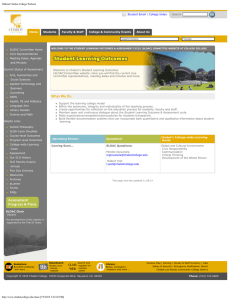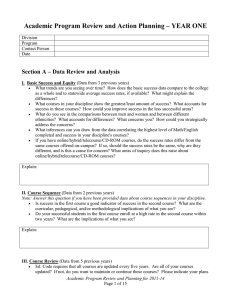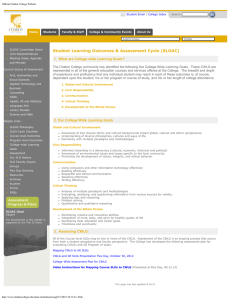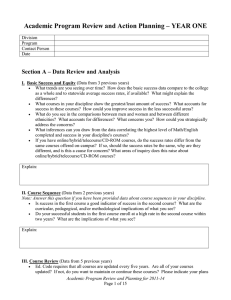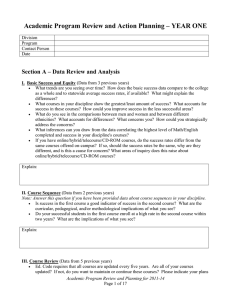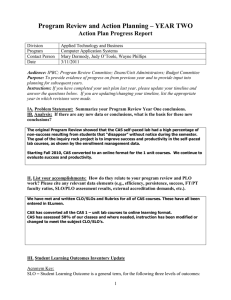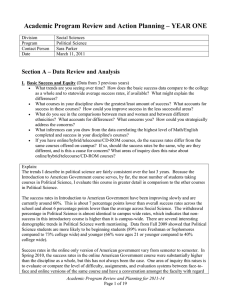Academic Program Review and Action Planning – YEAR ONE
advertisement
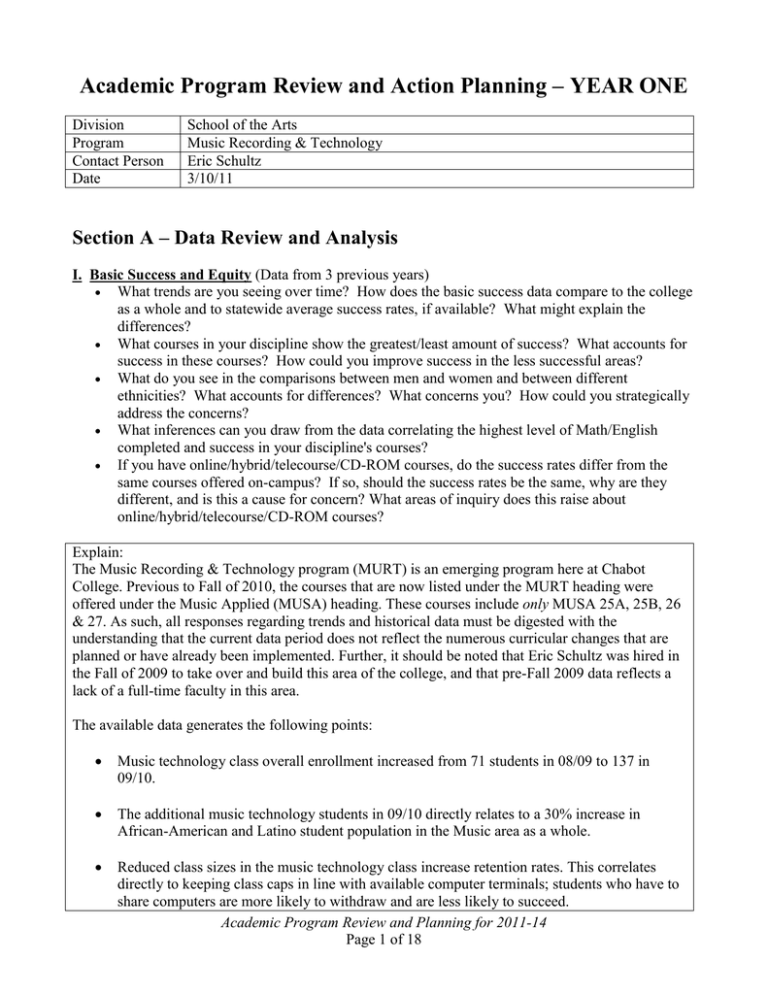
Academic Program Review and Action Planning – YEAR ONE Division Program Contact Person Date School of the Arts Music Recording & Technology Eric Schultz 3/10/11 Section A – Data Review and Analysis I. Basic Success and Equity (Data from 3 previous years) What trends are you seeing over time? How does the basic success data compare to the college as a whole and to statewide average success rates, if available? What might explain the differences? What courses in your discipline show the greatest/least amount of success? What accounts for success in these courses? How could you improve success in the less successful areas? What do you see in the comparisons between men and women and between different ethnicities? What accounts for differences? What concerns you? How could you strategically address the concerns? What inferences can you draw from the data correlating the highest level of Math/English completed and success in your discipline's courses? If you have online/hybrid/telecourse/CD-ROM courses, do the success rates differ from the same courses offered on-campus? If so, should the success rates be the same, why are they different, and is this a cause for concern? What areas of inquiry does this raise about online/hybrid/telecourse/CD-ROM courses? Explain: The Music Recording & Technology program (MURT) is an emerging program here at Chabot College. Previous to Fall of 2010, the courses that are now listed under the MURT heading were offered under the Music Applied (MUSA) heading. These courses include only MUSA 25A, 25B, 26 & 27. As such, all responses regarding trends and historical data must be digested with the understanding that the current data period does not reflect the numerous curricular changes that are planned or have already been implemented. Further, it should be noted that Eric Schultz was hired in the Fall of 2009 to take over and build this area of the college, and that pre-Fall 2009 data reflects a lack of a full-time faculty in this area. The available data generates the following points: Music technology class overall enrollment increased from 71 students in 08/09 to 137 in 09/10. The additional music technology students in 09/10 directly relates to a 30% increase in African-American and Latino student population in the Music area as a whole. Reduced class sizes in the music technology class increase retention rates. This correlates directly to keeping class caps in line with available computer terminals; students who have to share computers are more likely to withdraw and are less likely to succeed. Academic Program Review and Planning for 2011-14 Page 1 of 18 Increased class offerings, even at reduced class sizes increased profitable efficiency. WSCH/FTEF ratio for academic year 08/09 aggregated to 763.44; aggregate ratio from 09/10 was 870.97. The data shows that African-American students in the Applied Music courses demonstrate, by far, the largest non-success rate of any student population (36%/23% in 09/10). As the music technology courses demonstrate high populations of African-American students, these courses must be targeted for corrective steps to promote success rates among African-Americans. Aside from a continued pedagogical emphasis on musical styles that resonate with AfricanAmerican students, there are three important improvements that can be supported institutionally to address this issue: 1) increased staff support for more open lab times; 2) support for in-class learning assistants; 3) support for music technology tutors who are available during open lab hours. Making our valuable resource of the music technology lab more available and accessible for students who wish to work on both personal and class projects will promote increased opportunity for hands-on music making; this in turn will promote greater class success. Anecdotally, I am constantly asked by my students to provide more open lab hours, particularly African-American students who are looking for a vehicle for their creative outlets. If we make the lab more accessible, as well as providing trained support for lab users, I would expect success rates in general, but particularly among AfricanAmerican student populations to increase. The data, as well as anecdotal observation, also suggest that music technology classes are significantly disproportionate in terms of gender; music technology classes are heavily male. The music industry, particularly the recording and production aspects of it, are traditionally male-dominated and have been so for many years. I am seeing, again anecdotally, a slight increase in female enrollment this academic year, but by my count the largest percentage of females in any of my music technology classes in any semester has been 20%. This is concerning to me on many levels, and I am honestly not certain what can be done institutionally to increase female enrollment in these courses. II. Course Sequence (Data from 2 previous years) Note: Answer this question if you have been provided data about course sequences in your discipline. Is success in the first course a good indicator of success in the second course? What are the curricular, pedagogical, and/or methodological implications of what you see? Do your successful students in the first course enroll at a high rate in the second course within two years? What are the implications of what you see? Explain: N/A No course sequences in the data period. III. Course Review (Data from 5 previous years) Ed. Code requires that all courses are updated every five years. Are all of your courses updated? If not, do you want to maintain or continue these courses? Please indicate your plans in terms of curriculum. Have all of your courses been offered recently? If not, why? Are Academic Program Review and Planning for 2011-14 Page 2 of 18 students counting on courses to complete a program or major when these courses are not being offered? Explain: All MURT courses have been newly created either last semester or this one. IV. Budget Summary (Data from 3 previous years) What budget trends do you see in your discipline? What are the implications of these trends? Where is your budget adequate and where is it lacking? What are the consequences on your program, your students, and/or your instruction? What projected long-term (5-10 years) budget needs do you see? You will detail your short-term needs in the action plan that follows. You do not need to cite them here. Explain: Upon my hiring at Chabot College, there has been no budget specific to the music technology area. Obviously, this is a tremendous limitation. There are four primary areas of budgetary need in the music technology program. I will list them below, along with commentary about what steps are being taken or need to be taken to provide budgetary support. 1) Course offerings: the forthcoming Associate’s Degree/Certificate programs in Music Industry & Technology require 27 credits of core technology and industry courses. These courses have been approved by the Curriculum Committee and are currently set for full implementation beginning in the Fall of 2011. These courses have been extremely carefully planned on a 2-semester rotation with the absolute bare minimum in annual FTEF allocation. Any cuts to the courses being offered will inhibit the ability for students to complete the program in a timely manner. 2) Software: Currently, the music technology lab and recording studio are operating with an extremely limited menu of music recording and production software. Further, the existing software is presently out of date. The availability of relevant, industry-standard, up to date software in this course of study is absolutely crucial, and we are at this point significantly behind the curve. 3) Hardware: The music technology program, similar to other vocational programs on campus, relies heavily on up-to-date, industry standard audio hardware in both the music technology lab as well as the recording studio. Some of the big-ticket hardware needs of the program are being covered financially by the Bond-funded remodel of the 1200 building, but there are significant needs that have yet to be funded. 4) Support staff: Currently, our music technology lab maintains only 5 hours of open lab time per week, supervised by a wonderful staff member whose training is in other areas of digital media. These hours are morning-only hours, which severely limits student accessibility to the lab. Adding a part-time music technology lab monitor with training specific to the unique needs of relevant music software and hardware should substantially increase both student success within music technology classes, as well as fostering a greater sense of community within the area and promoting healthy and creative outlets for students whose non-academic Academic Program Review and Planning for 2011-14 Page 3 of 18 lives might be challenging or dangerous. Further, student assistants would substantially increase student success in class as it would allow a doubling of one-on-one attention for students who are independently working on class projects. These two aspects of institutional support would, I believe, dramatically increase student success in the music technology area. Any long-term budgetary plans must take into consideration the fact that we will be opening a 2300 square foot music technology addition to the 1200 building in the Fall of 2012, which will feature a proper recording studio. The potential for this recording facility to offer hands-on, real-world training with external clients is enormously beneficial, similar to the current programs in auto repair and dental hygiene. However, any kind of semi-professional use of the recording studio will require a full-time staff position to properly supervise and administer the studio and supervise sessions. Beyond the operation of a student-staffed semi-professional recording studio, it should be noted that any long-term plans in the field of music recording and technology must include appropriate budgetary expenditures for the constant upgrading and acquisition of industry-standard, up to date software and hardware. V. Enrollment Data (Data from 2 previous years) Please provide a brief description of: overall enrollment trends; enrollment trends by course; and enrollment trends by time of day and Saturday. Describe what your discipline has done in terms of curriculum or scheduling in the last two years that has effected enrollments. Describe plans or strategies that you have for the near future in terms of curriculum or scheduling that could impact your enrollments. Lastly, look closely at whether the schedule you currently offer provides access to the broader community that your discipline serves at Chabot College—day time, night time, Saturday, distance education, special or targeted communities that would or do enroll in your courses. Explain: As previously stated, the enrollment in music technology courses has grown substantially in the past year, and with the addition of the new curriculum and degree/certificate programs, will continue to grow as much as the FTEF allocation will allow. Anecdotally, I have turned away at least 10-15 students per section for every MURT course that has been offered this academic year. The word has gotten out in the community about the success of this program, and there are an abundance of interested students. We did, this past Fall, begin offering a Friday course in advanced recording, which has been remarkably successful. Currently, our course offerings are limited to exclusively to daytime classes. At the end of the 09/10 school year, I took a poll among all the music technology students to find out what days and times worked best to offer courses. The results leaned towards morning and afternoon offerings, but did indicate that if there were evening courses in music technology that there would be substantial interest. Presently, the FTEF allocation does not allow for additional sections above what is minimally required to keep the degree/certificate programs in tact; that said, I believe that evening Academic Program Review and Planning for 2011-14 Page 4 of 18 offerings would open up the possibility of this program to a vast and yet unseen community demographic. VI. Student Learning Outcomes Inventory Acronym Key: SLO = Student Learning Outcome is a general term, for the following three levels of outcomes: CLO = Course-level Outcome, i.e. what a student can do after completing a course PLO= Program-level Outcome, i.e. what a student can do after completing a sequence of courses CWLG = College-wide Learning Goal Percentage of courses in your discipline that have CLOs and rubrics developed:___0%______ For this information, please see the list of which courses do and do not have CLOs on the SLOAC’s main webpage: http://www.chabotcollege.edu/sloac/default.asp Percentage of courses in your discipline that have the minimum number of CLOs developed: (1 unit = 1 or more CLO, 2 units = 2 or more CLOs, 3 or more units = 3 or more CLOs)____0%___ For this information, please see the CLO spreadsheet on the SLOAC’s main webpage: http://www.chabotcollege.edu/sloac/default.asp Date the CLO Assessment schedule was submitted:____Spring 2010____ For this information, please see the Course-level Outcomes assessment schedules list from the Assessment Progress and Plans webpage: http://www.chabotcollege.edu/sloac/progress.asp Percentage of courses in your discipline that have had all the CLOs assessed within the past three years, as per Chabot’s Assessment policy: ___0%____ For this information, please see Chabot’s Assessment Policy from the SLO/Assessment Guidelines webpage: http://www.chabotcollege.edu/sloac/guidelines.asp Percentage of courses in your discipline that have had all the CLO assessments reflected upon, or discussed with colleagues, within the past three years____0%___ What questions or investigations arose as a result of these reflections or discussions? Explain: What actions has your discipline determined that might be taken as a result of these reflections, discussions, and insights? Actions planned: Academic Program Review and Planning for 2011-14 Page 5 of 18 What course-level and programmatic strengths have the assessment reflections revealed? Strengths revealed: Percentage of programs within your discipline that have established at least two PLOs, and mapped appropriate CLOs to them:____0%____ For this information, please see the Program-level Outcomes progress page from the Assessment Progress and Plans webpage: http://www.chabotcollege.edu/sloac/progress.asp Which of the CWLGs do your discipline’s CLOs address? _____CT, COM_________________________________________________________________________ ____________________________ In which if any of the College-wide Learning Goals Faculty Inquiry Groups have discipline member(s) participated? _____none____________________________________________________ ______________________________________________________________________________ Insights gained: VII. Academic Learning Support What kinds of academic learning support does your discipline use or require to help students succeed (e.g., tutoring, learning assistants, student assistants, peer advisors, lab support, supplemental instruction, peer-led team learning, peer advisors)? How many hours per semester do you use and/or how many hours per semester do you need? Explain: None of the MURT courses currently use any academic learning support resources. Ideally, every introductory-level technology course (MURT 21, MURT 22A, MURT 25) would have a dedicated student or learning assistant. At present course offering models, this would equal 4 3credit courses each Fall and 1 1-credit course in the Spring. VIII. External Data Cite any relevant external data that affects your program (e.g., labor market data, community demand, employment growth, external accreditation demands, etc.). In a recent study by the Berklee School of Music, it was noted that careers in music business, music technology and music/social networking industry are the areas experiencing the most growth in terms Academic Program Review and Planning for 2011-14 Page 6 of 18 of job creation. It is worth noting that in the bay area, there are a very limited number of options for degree acquisition in the field of music industry and technology. The competition for our program here at Chabot is, quite frankly, very slim. Foothill college offers an A.S. degree in music technology and recording at the same price as Chabot, but the location and population demographics of Foothill versus Chabot is strikingly different. San Francisco State University offers a community education program in music industry and technology, but only offers a certificate of completion. Further, the price for these courses is approximately $500-700 per class. Ex’pressions College in Emeryville offers 4-year undergraduate degrees in a number of music industry/technology specializations, however the price is exorbanent at around $20,000 per academic year. It should also be noted that Ex’pressions College was disaccredited by WASC for a number of years and only recently was reaccredited. Given the above information, it should be very clear that a strong vocational program in music industry and technology here at Chabot College would be not only an asset to our campus community, but point of pride and opportunity for the underrepresented, socio-economically disenfranchised and ethnically diverse regional community as a whole. It is no secret that as a result of online digital music distribution networks (both legal and otherwise) the music industry is undergoing a period of extreme change. These changes are essentially creating a new and very fruitful open market for independent music makers and producers. The goal of the Music Industry and Technology program at Chabot College is to give our students the technical expertise, business savvy and musical/creative prowess to succeed in the increasingly independent music industry. As a result of this, as well as the project-based nature of the commercial music business, hard data regarding job placement and statistical “success” is somewhat illusive. One indication of the potential success of our program can be seen in the story of Chrystl-Violett Bickham, a current student in the music technology program who was hired this February as a fulltime music studio technician at the Academy of Art in San Francisco. Chosen from an applicant pool of over 40, Chrystl states that her education here at Chabot in the music technology program (even though she has not even completed the entire curriculum yet) was essential preparation for this fulltime salary-with-benefits position. The fact that Chrystl is a 21-year-old African-American female is particularly encouraging. Academic Program Review and Planning for 2011-14 Page 7 of 18 Section B – Data Summary From what you have learned in your basic data review, what does the information tell you about your program? Overall, what improvements would you like to make to your program? How do you plan to address these concerns? Are there any immediate issues that require immediate attention (e.g., outdated course outlines)? Where appropriate, please cite relevant data in your discussion (e.g., efficiency, persistence, success, FT/PT faculty ratios, SLO/PLO assessment results, external accreditation demands, etc.). Data Summary and Plan of Action Description/Rationale: At this juncture, the data regarding the music technology area does not adequately represent the newly implemented direction in curriculum and pedagogy. That said, the increased enrollment, outstanding efficiency rates, substantially lower withdrawal percentages, and increase in AfricanAmerican and Latino enrollment do seem to confirm that on many levels the program is headed in the right direction. Further, the forthcoming A.S. and Certificate programs (pending approval) as well as the dramatic and exciting new facilities provided by the Measure B funds are setting this program up for remarkable long-term big-picture success. That said, this is yet a crucial point for this program. Immediate concerns are as follows. FTEF allocation for the pending degree/certificate program is currently at its lowest minimum sustainable level. Any cuts to course offerings in the MURT program will reduce the ability for students to complete the curricular requirements in a timely manner. Our music technology software and hardware situation is detrimentally outdated and needs to be brought up to current industry standard levels. MURT course SLO’s need to be assessed and PLO’s need to be drafted and implemented. A half-time staff position to expand the accessibility and expertise of supervision of the music technology open lab hours would tremendously benefit student success rates as well as providing a creative outlet for some of our most at risk student populations. This will be particularly relevant and necessary when the new facility opens in Fall 2012. Section C – Action Planning Please propose a two-year plan of action and timeline to address any immediate and/or long-term concern(s). This includes activities to assess the CLO(s) to discover a plan of action. It may also include specific activities that address improving CLO(s) and their assessment, that is to say evaluating the CLO(s) and the assessment activities. 8 Examples of activities include: Research and inquiry project – why is this happening? Innovation and Pilot Projects – this is something I want to try Intervention activities such as support services – this is what I want to do about it Program and curriculum modification – this is what I want to do about it 9 I. Action Plan Timeline: Detail the timeline for accomplishing your goals PLOs and/or Program Goal(s) Timeline Activity Support Needed to Accomplish These Activities* Outcome(s) Expected Person(s) Responsible Update music tech software Fall 2011 Obtain budgetary expenditure Software budget approval; Potential external grant support; Support for faculty training in new software Updating of existing software Eric Schultz to current versions; Acquisition of relevant industry-standard new software for music technology lab Update outdated music recording hardware Fall 2012 Obtain budgetary expenditure Budget committee approval; Potential external grant support Replacement of currently outdated hardware with industry-standard equipment; Purchase of new hardware where none presently exist Eric Schultz Decrease non-success rates among African-American student populations Fall 2012 Add student assistants to introductory level classes; expand open lab hours in music technology lab with a lab monitor with relevant music software expertise; continued emphasis on culturally relevant musical styles; Approval for student assistants; half-time staff position for music technology lab 5%-10% improvement of nonsuccess rates (from 09/10 levels) among AfricanAmerican students Eric Schultz Add a half-time staff position for music technology lab Fall 2012 Hire a 20-hour staff member Staff position approval trained in the relevant music software and hardware to increase accessibility and effectiveness of open lab times Accomplished? Yes/No/In Progress YEAR ONE LEAVE BLANK Implementation of new staff Eric Schultz position in time for the opening of our new facility in the Fall of 2012 Definitions of terms: Program Goal = A general statement of what the program hopes to accomplish, for the long-term. It may be in qualitative (narrative) rather than quantitative (numeric) terms. It may include the integration of several program outcomes, or relate to class scores, credits, units, course 10 completion, retention term to term, progression to next course/level, program completion, degree and certificate completion, transfer, success/scores on licensure exams, job placement, attitudes, fundraising, media promotion, etc. PLO = Program-level Outcome, i.e., what students can do, what knowledge they have, after completing a sequence of courses. It is a subset of the Program Goals, related to student learning. *Types of Support Needed to Accomplish Activities: Training or workshops Publications, library, resources Guidance to support research and/or inquiry projects Technology II. Strategic Plan Goals and Summaries: Which Strategic Plan goals and strategies does your action plan support? Awareness and Access Increase familiarity with Chabot Reach out to underrepresented populations Promote early awareness and college readiness to youth and families Multiple ways to deliver instruction and services for all Student Success Strengthen basic skills development Identify and provide a variety of career paths Increase success for all students in our diverse community Assess student learning outcomes to improve and expand instruction and services Community Partnership Increase experiential learning opportunities Initiate/expand partnerships among the college, businesses and community organizations Promote faculty and staff involvement in college and community activities Engage the community in campus programs and events Vision Leadership and Innovation Improve institutional effectiveness Streamline academic and student support services 11 Professional development to support teaching, learning and operational needs Support effective communication both in the college and the community Provide safe, secure and up-to-date facilities and technology 12 Program Review and Action Planning – YEAR TWO Action Plan Progress Report Division Program Contact Person Date Audience: IPBC; Program Review Committee; Deans/Unit Administrators; Budget Committee Purpose: To provide evidence of progress on from previous year and to provide input into planning for subsequent years. Instructions: If you have completed your unit plan last year, please update your timeline and answer the questions below. If you are updating/changing your timeline, list the appropriate year in which revisions were made. IA. Problem Statement: Summarize your Program Review Year One conclusions. IB. Analysis: If there are any new data or conclusions, what is the basis for these new conclusions? II. List your accomplishments: How do they relate to your program review and PLO work? Please cite any relevant data elements (e.g., efficiency, persistence, success, FT/PT faculty ratios, SLO/PLO assessment results, external accreditation demands, etc.). III. Student Learning Outcomes Inventory Update Acronym Key: SLO = Student Learning Outcome is a general term, for the following three levels of outcomes: CLO = Course-level Outcome, i.e. what a student can do after completing a course PLO= Program-level Outcome, i.e. what a student can do after completing a sequence of courses CWLG = College-wide Learning Goal 13 Percentage of courses in your discipline that have CLOs and rubrics developed:_________ For this information, please see the list of which courses do and do not have CLOs on the SLOAC’s main webpage: http://www.chabotcollege.edu/sloac/default.asp Percentage of courses in your discipline that have the minimum number of CLOs developed: (1 unit = 1 or more CLO, 2 units = 2 or more CLOs, 3 or more units = 3 or more CLOs)_______ For this information, please see the CLO spreadsheet on the SLOAC’s main webpage: http://www.chabotcollege.edu/sloac/default.asp Date the CLO Assessment schedule was submitted:________ For this information, please see the Course-level Outcomes assessment schedules list from the Assessment Progress and Plans webpage: http://www.chabotcollege.edu/sloac/progress.asp Percentage of courses in your discipline that have had all the CLOs assessed within the past three years, as per Chabot’s Assessment policy: _______ For this information, please see Chabot’s Assessment Policy from the SLO/Assessment Guidelines webpage: http://www.chabotcollege.edu/sloac/guidelines.asp Percentage of courses in your discipline that have had all the CLO assessments reflected upon, or discussed with colleagues, within the past three years_______ What questions or investigations arose as a result of these reflections or discussions? Explain: What actions has your discipline determined that might be taken as a result of these reflections, discussions, and insights? Actions planned: What course-level and programmatic strengths have the assessment reflections revealed? Strengths revealed: Percentage of programs within your discipline that have established at least two PLOs, and mapped appropriate CLOs to them:________ For this information, please see the Program-level Outcomes progress page from the Assessment Progress and Plans webpage: http://www.chabotcollege.edu/sloac/progress.asp Which of the CWLGs do your discipline’s CLOs address? _________________________________________________________________________ _________________________________________________________________________ 14 In which if any of the College-wide Learning Goals Faculty Inquiry Groups have discipline member(s) participated? _________________________________________________________________________ _________________________________________________________________________ Insights gained: VII. Academic Learning Support What kinds of academic learning support does your discipline use or require to help students succeed (e.g., tutoring, learning assistants, student assistants, peer advisors, lab support, supplemental instruction, peer-led team learning, peer advisors)? How many hours per semester do you use and/or how many hours per semester do you need? Explain: IV. External Data Cite any relevant external data that affects your program (e.g., labor market data, community demand, employment growth, external accreditation demands, etc.). 15 V. Action Plan Timeline Update: Cut and paste your previous timeline from Year One and update the “Accomplished?” column. List any new PLOs or program goals and activities you may have in the second chart. PLOs and/or Program Goal(s) from Year One Timeline Activity Support Needed to Accomplish these Activities* Outcome(s) Expected Person(s) Responsible Accomplished? Yes/No/In Progress New PLOs and/or Program Goal(s) Timeline Activity Support Needed to Accomplish these Activities* Outcome(s) Expected Person(s) Responsible Accomplished? Yes/No/In Progress YEAR TWO LEAVE BLANK 16 Definitions of terms: 1. Program Goal = A general statement of what the program hopes to accomplish, for the long-term. It may be in qualitative (narrative) rather than quantitative (numeric) terms. It may include the integration of several program outcomes, or relate to class scores, credits, units, course completion, retention term to term, progression to next course/level, program completion, degree and certificate completion, transfer, success/scores on licensure exams, job placement, attitudes, fundraising, media promotion, etc. PLO = Program-level Outcome, i.e., what students can do, what knowledge they have, after completing a sequence of courses. It is a subset of the Program Goals, related to student learning. *Types of Support Needed to Accomplish Activities: Training or workshops Publications, library, resources Guidance to support research and/or inquiry projects Technology 12 Program Review and Action Planning – YEAR THREE Final Summary Report Division Program Contact Person Date I. Reflect upon the last three years' analysis and activities. II. Briefly summarize the accomplishments of the discipline, and how they relate to the review of the program, the program-level outcomes (PLOs) and course-level outcomes (CLOs). III. Please list what best practices (e.g., strategies, activities, intervention, elements, etc.) you would recommend? What was challenging? Was there a barrier(s) to success? Best practices: Challenges/Barriers to Success: IV. Next Steps: Recommendations for program and institutional improvement. Program Improvement: Institutional Improvement: 13
